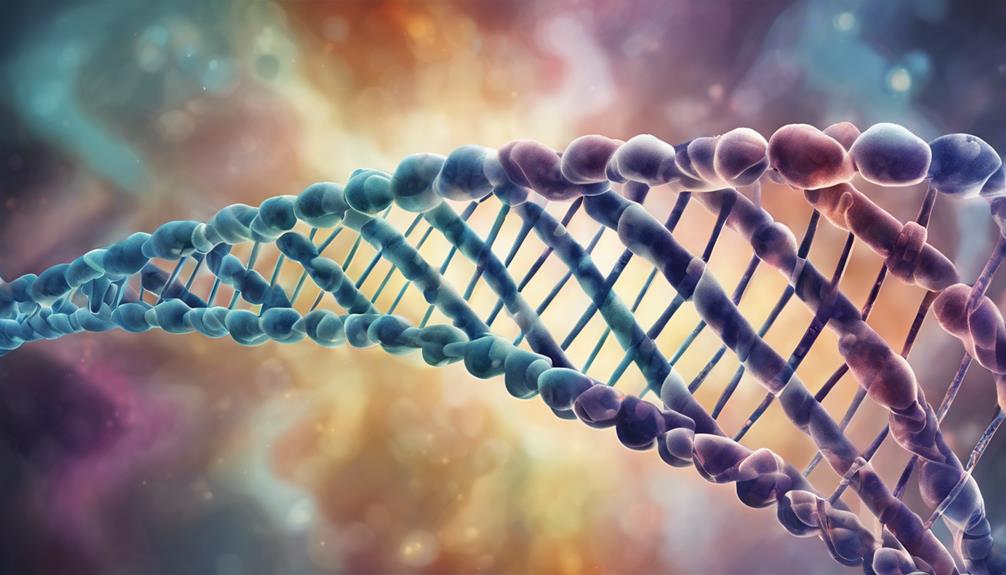Human DNA serves as the intricate blueprint that guides the complex machinery of life, orchestrating the symphony of biological processes that define human existence. From the precise pairing of nucleotides to the intricate dance of transcription and translation, DNA's workings are a marvel of nature's engineering. Understanding the mechanics of DNA not only unravels the mysteries of heredity but also sheds light on the intricate tapestry of human health and disease. The profound implications of DNA's functioning extend far beyond the confines of a double helix, offering a glimpse into the very essence of what makes us human.
Key Takeaways
- Human DNA stores genetic information crucial for protein synthesis and individual traits.
- DNA replication ensures accurate transmission of genetic blueprint during cell division.
- Understanding the double helix structure is fundamental for genetic information storage and transmission.
- DNA mutations can lead to genetic disorders, emphasizing the importance of DNA's role in health.
DNA Location
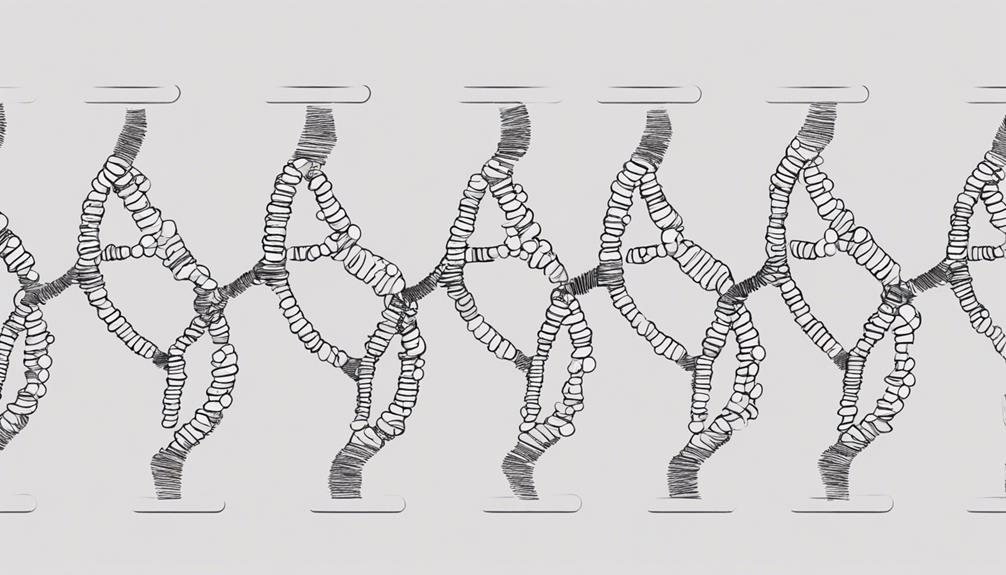
The localization of human DNA within cells is predominantly within the nucleus, housing the vast majority of the genetic material that dictates the functioning and characteristics of an individual. While the nucleus contains most of the approximately 3 billion base pairs that constitute human DNA, a small fraction of DNA is also present in the mitochondria. Mitochondrial DNA, inherited maternally, plays a critical role in energy production within cells. This separate genome within the mitochondria is essential for cellular functions, particularly in energy metabolism. Mutations in mitochondrial DNA can have significant implications, as they can disrupt the vital process of energy production and ultimately affect various cellular functions. Understanding the distribution of DNA within the cell is crucial for comprehending how genetic information is utilized to regulate different biological processes and maintain the overall functionality of an organism.
Composition of DNA
Comprising nucleotides with distinct chemical components, DNA serves as the intricate blueprint guiding the genetic instructions essential for biological processes. The structure of DNA is composed of nucleotides, which consist of a phosphate group, a deoxyribose sugar, and four nitrogen bases: adenine, cytosine, guanine, and thymine. These nitrogen bases pair specifically – adenine with thymine and cytosine with guanine – forming the characteristic double helix configuration of DNA. Human DNA is vast, containing approximately 3 billion base pairs, with only a small percentage coding for genes. Genes are specific segments of DNA that carry the instructions for various biological functions, including protein synthesis. Understanding the composition of DNA, its nucleotide sequence, and the genetic information it holds is crucial in comprehending the intricate workings of human DNA within cells. The intricate interplay of these components forms the basis of genetic inheritance and the diversity of life.
DNA Function
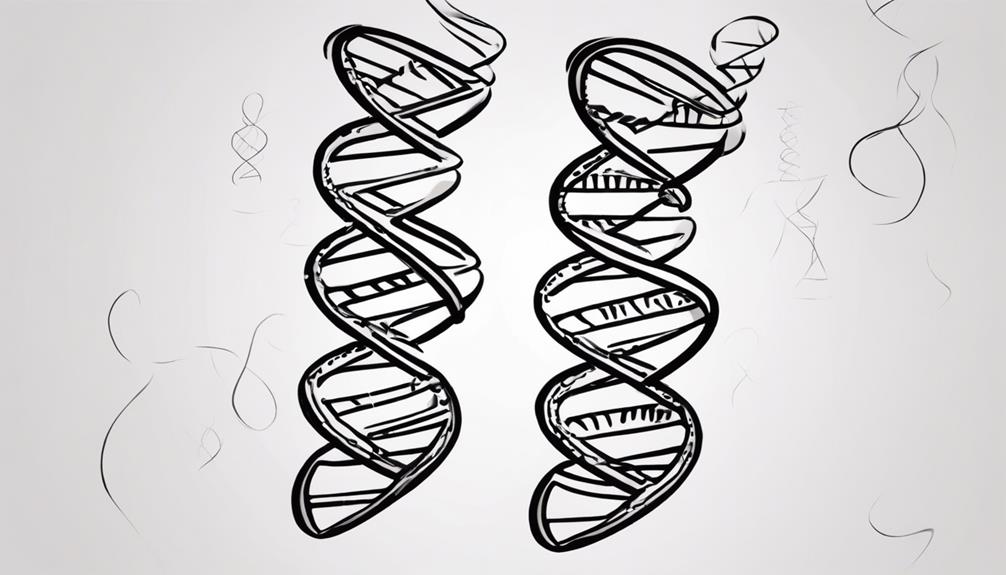
DNA function is a complex process central to the functioning of all living organisms. It serves as the repository of genetic information, containing instructions crucial for protein synthesis and various biological processes. Through the intricate mechanisms of enzyme transcription and translation, DNA governs the intricate machinery of life at a molecular level.
Genetic Information Storage
Remarkably, the intricate process of genetic information storage within human DNA is orchestrated through the arrangement of nucleotide sequences. Genes, segments of DNA, contain the instructions essential for protein synthesis and various cellular functions. This genetic blueprint influences an organism's development, growth, and maintenance. The specific sequence of nucleotides in DNA is crucial, as it determines the traits and characteristics of an individual. Additionally, DNA's remarkable ability to replicate ensures the accurate transmission of genetic information to new cells.
| DNA Facts | |
|---|---|
| Genetic Information | Nucleotide Sequences |
| Genes | Protein Synthesis |
| Traits | Replication |
| Development & Growth | Maintenance |
Protein Synthesis Instructions
The process of protein synthesis, intricately governed by the genetic instructions encoded in DNA, plays a fundamental role in the functionality and structure of living organisms.
Key Steps in Protein Synthesis:
- Transcription: Enzymes transcribe DNA into messenger RNA (mRNA) by copying the genetic information from genes.
- mRNA Transport: The mRNA carries the copied genetic information from DNA in the nucleus to the ribosomes in the cytoplasm.
- Translation: At the ribosomes, the mRNA sequence is read, and amino acids are assembled according to the sequence to form proteins.
These steps highlight the intricate process of protein synthesis, where genes provide the blueprint for the creation of essential proteins within living organisms.
Protein Synthesis From DNA
In the process of protein synthesis from DNA, genetic information is transcribed into mRNA, which is then translated by ribosomes to assemble specific amino acids into proteins. This intricate mechanism relies on the accurate sequence of nucleotides in DNA to determine the sequence of amino acids in proteins. The role of transfer RNA (tRNA) molecules is crucial, as they ferry the correct amino acids to the ribosome according to the mRNA code, culminating in the formation of functional proteins essential for cellular processes.
DNA to Mrna
Transcription is the fundamental biological process through which DNA is converted into mRNA, facilitating the transmission of genetic information for protein synthesis. During this intricate process:
- Enzymes bind to the DNA molecule and unwind it to expose the gene of interest.
- The enzyme RNA polymerase reads the DNA sequence and synthesizes a complementary mRNA strand.
- The newly formed mRNA carries the genetic information in the form of codons, which represent specific amino acids.
This transcribed mRNA molecule then serves as a template for the translation process, where tRNA molecules match the mRNA codons with the corresponding amino acids to ultimately produce functional proteins.
Ribosome Translation Process
Following the transcription of DNA into mRNA, the ribosome translation process plays a crucial role in converting the genetic information carried by mRNA into functional proteins within the cell. Ribosomes, the cellular organelles, facilitate protein synthesis by coordinating mRNA, tRNA, and ribosomal subunits. During translation, tRNA molecules carrying specific amino acids bind to the mRNA codons, and the ribosome links these amino acids together, forming a polypeptide chain according to the mRNA instructions. Ribosomes move along the mRNA strand, reading the codons sequentially and assembling the corresponding amino acids. This intricate process of protein synthesis is essential for the cell to carry out its functions effectively.
| Ribosome | tRNA | mRNA |
|---|---|---|
| Site of translation | Carries amino acids | Carries genetic info |
| Essential for protein synthesis | Matches amino acids to codons | Template for protein production |
Protein Formation Steps
Initiating with the genetic blueprint encoded in DNA, the intricate process of protein synthesis unfolds through a series of meticulously orchestrated steps culminating in the formation of functional proteins within the cell.
- DNA Structure: The double helix structure of DNA contains nucleotides that encode genetic information.
- mRNA Transcription: DNA undergoes transcription to produce mRNA, which carries the genetic code for protein synthesis.
- Amino Acid Assembly: mRNA is translated into amino acids by tRNA, following the codons in the mRNA sequence, and these amino acids are then joined together according to the mRNA instructions to form proteins.
This process, central to all life forms, is fundamental to the functioning of cells and the overall biological processes in living organisms.
DNA Discoverer
James Watson and Francis Crick, along with Maurice Wilkins, are credited with the groundbreaking discovery of the double helix structure of DNA in 1953. Rosalind Franklin's X-ray diffraction images provided crucial insights into the helical structure of DNA. This structural revelation marked a significant milestone in genetics and molecular biology. Despite Franklin's essential contributions, the Nobel Prize in Physiology or Medicine in 1962 was awarded to Watson, Crick, and Wilkins for their collective efforts in unraveling the DNA structure. The discovery of the double helix configuration fundamentally transformed our understanding of heredity and paved the way for advancements in genetic research. By elucidating the structural basis of DNA, these scientists laid the foundation for modern molecular biology and genetics, enabling a deeper comprehension of how human DNA functions at a fundamental level. This landmark discovery continues to shape scientific inquiry and innovation in the field of genetics.
DNA Double Helix
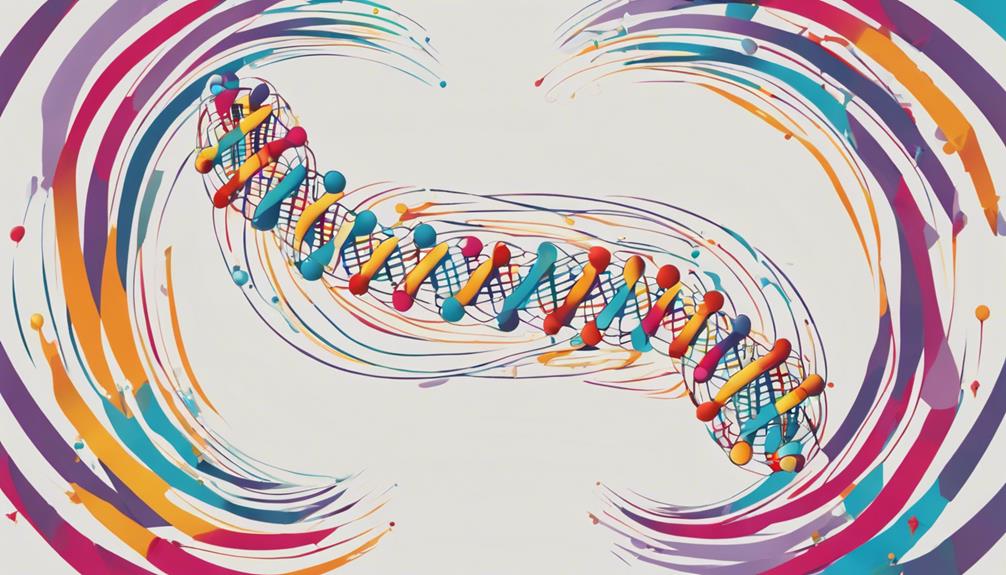
Having unraveled the double helix structure of DNA in 1953, scientists laid the foundation for understanding the fundamental architecture of human genetic material. The DNA double helix structure consists of two intertwined strands of nucleotides, forming a twisted ladder shape with sugar-phosphate backbones and nitrogen base pairs. Adenine always pairs with thymine, and guanine always pairs with cytosine in the double helix, creating a stable structure held together by hydrogen bonds. This specific base pairing is crucial as it allows for accurate replication and transmission of genetic information during processes like cell division. The complementary nature of the nitrogen base pairs ensures that the genetic code is faithfully passed on from one generation to the next. Understanding the intricate double helix structure of DNA is essential in comprehending how genetic information is stored, replicated, and expressed within living organisms.
Impact of DNA on Health
The impact of DNA on health is paramount, influencing the development and progression of various genetic disorders and diseases. Mutations in human DNA play a crucial role in the onset of genetic diseases like cystic fibrosis and cancer. Genetic disorders are often a result of abnormalities in DNA replication, leading to faulty cell functioning. These mutations can have profound implications for an individual's health outcomes, as they can predispose individuals to certain illnesses. Additionally, DNA damage caused by external factors such as UV radiation, chemicals, and other environmental stressors can contribute to the manifestation of diseases and overall health deterioration. Understanding the connection between DNA mutations and health is vital for disease prevention and treatment strategies. Moreover, as DNA undergoes degradation over time, it can impact the aging process and give rise to age-related health issues. Therefore, investigating DNA's role in health is essential for advancing medical interventions and promoting healthier living.
Telomeres and DNA
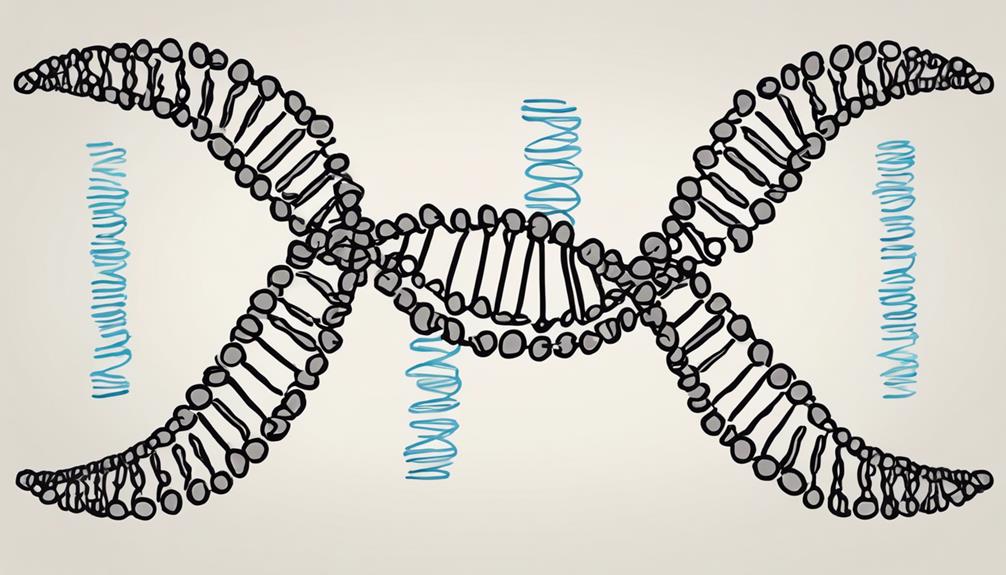
Telomeres, repetitive DNA sequences found at the end of chromosomes, play a critical role in safeguarding genetic information and maintaining chromosome stability during cell division. These specialized structures have significant implications for cellular health and aging:
- Genetic Protection: Telomeres act as protective caps at the end of chromosomes, shielding essential genetic material from degradation or fusion with neighboring chromosomes.
- Chromosome Stability: By preventing the loss of genetic material during cell replication, telomeres ensure that chromosomes remain intact and functional, promoting cellular stability.
- Aging and Cell Senescence: Telomeres naturally shorten with each cell division. This shortening process is linked to aging and cellular senescence, where cells cease to divide further.
Moreover, the enzyme telomerase plays a crucial role in maintaining telomere length, particularly in cells with high replication rates such as stem cells. Understanding the dynamics of telomeres and their impact on DNA stability provides valuable insights into aging, diseases, and overall cellular well-being.
Types of DNA
Within the realm of genetics, human DNA can be categorized into distinct types, each serving unique biological functions and playing pivotal roles in various cellular processes. Deoxyribonucleic Acid (DNA) is the fundamental molecule that carries genetic information in humans. There are two primary types of DNA: nuclear DNA and mitochondrial DNA. Nuclear DNA is located within the cell nucleus and contains the majority of genetic material responsible for individual traits and characteristics. It is inherited from both parents and housed within chromosomes. In contrast, mitochondrial DNA is found in the mitochondria and is crucial for energy production in the cell. This type of DNA is maternally inherited, passing down genetic information exclusively from the mother's side. Both nuclear and mitochondrial DNA are composed of nucleotides, the building blocks that make up the genetic code. Mutations in these DNA molecules can lead to genetic disorders and various health conditions, highlighting the importance of understanding the roles of each type of DNA in human biology.
DNA Replication Process
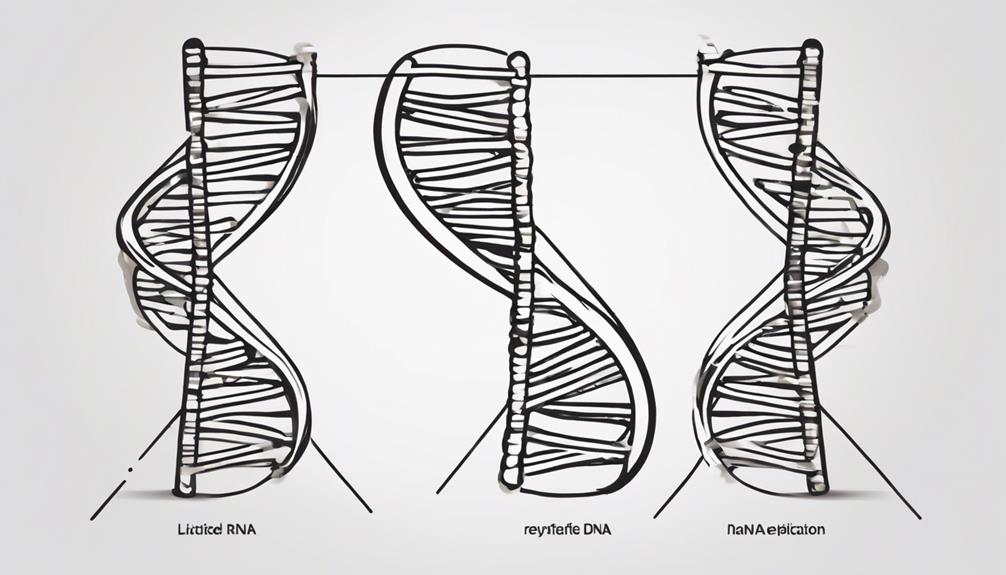
Following the elucidation of the distinct types of human DNA, the DNA replication process stands as a fundamental mechanism ensuring the accurate duplication of genetic information during cell division.
- Double Helix Unwinding: DNA replication is a semi-conservative process where the double helix unwinds, exposing the two strands for replication.
- Enzymatic Machinery: Enzymes such as DNA helicase play a crucial role in unwinding the double helix, while DNA polymerase adds nucleotides to form the new complementary strands.
- Leading and Lagging Strands: The leading strand is synthesized continuously in the 5' to 3' direction, while the lagging strand is synthesized discontinuously in short Okazaki fragments. These fragments are later joined by DNA ligase to form a complete strand.
DNA replication initiates at specific sites called origins of replication and proceeds bidirectionally until the entire DNA molecule is copied. This intricate process ensures the faithful transmission of genetic information, crucial for growth, development, and repair processes in living organisms.
Genetic Disease Treatment
Genetic disease treatment involves innovative techniques like gene editing and targeted therapy to address specific genetic mutations causing diseases. These approaches aim to correct or mitigate the effects of faulty genes, offering personalized treatment options for individuals with genetic disorders. Additionally, advancements in pharmacogenomics and stem cell therapy are providing promising avenues for the management and potential cure of certain genetic diseases.
Gene Editing Techniques
Gene editing techniques, such as CRISPR-Cas9, offer a promising avenue for treating genetic diseases by targeting and correcting specific mutations within human DNA.
Imagery:
- CRISPR-Cas9 acts like precision scissors, snipping out faulty DNA sequences.
- Healthy genetic material is then inserted to replace the removed segments.
- This process allows for the correction of underlying genetic causes of diseases.
These advanced technologies provide hope for treating previously untreatable genetic disorders. However, ethical considerations and safety concerns loom large over the use of gene editing techniques in humans. Regulation and oversight are crucial to ensure the responsible and safe application of these powerful tools in the realm of genetic disease treatment.
Targeted Therapy Approaches
In the realm of genetic disease treatment, precision medicine techniques are harnessed to target and correct specific genetic mutations at the molecular level. This approach allows for the customization of treatment based on an individual's DNA sequence, offering personalized solutions for genetic disorders. Gene editing tools like CRISPR-Cas9 play a crucial role in this targeted therapy by enabling precise modifications to faulty genes, aiming to restore normal cellular functions. By addressing the root cause of genetic mutations, targeted therapy provides promising outcomes for patients, offering more efficient and tailored treatment options. The table below highlights key aspects of targeted therapy approaches in genetic disease treatment:
| Targeted Therapy Approaches | Key Points |
|---|---|
| Precision Medicine | Tailors treatment to DNA |
| Gene Editing | Enables precise modifications |
| Personalized Treatment | Customized solutions |
| Promising Outcomes | More efficient treatments |
Frequently Asked Questions
How Does DNA Work in Simple Terms?
DNA works through processes like replication, gene expression, and protein synthesis. It carries genetic information that determines traits and inheritance patterns. Mutations in DNA can lead to genetic disorders. DNA sequencing helps in understanding these variations. The sequence of nucleotides in DNA guides the production of proteins, essential for body functions. Understanding DNA's role in protein production is crucial for comprehending genetic disorders and inheritance patterns.
How Do Humans Get Their Dna?
Genetic inheritance in humans involves the contribution of 23 chromosomes from each parent during fertilization. This process results in the formation of a unique DNA sequence in offspring, reflecting a blend of parental genetic material. Through DNA replication, chromosomal pairing, and cellular division, the 46 chromosomes are passed down, preserving genetic traits. Variations in DNA sequencing can occur, leading to genetic diversity and potential health implications within families.
Does DNA Change in a Person?
Genetic mutations can indeed occur in a person's DNA during their lifetime due to environmental factors, leading to changes in their inherited traits. These mutations can result from various sources like UV radiation, chemicals, and lifestyle choices. Understanding how DNA changes can provide insights into genetic diseases, cancer risks, and evolutionary modifications. Genetic testing can help identify these alterations, while factors like DNA replication and epigenetic modifications also play crucial roles in DNA stability.
Is Our DNA 100% Human?
While human DNA is predominantly human, it also contains non-human elements like viral remnants. These genetic contributions from viruses, about 8% of the genome, showcase our genetic ancestry and past interactions with viruses. These findings hint at evolutionary implications, potential hybrid species or interspecies breeding, genetic mutations, and aid in understanding species differentiation. Overall, studying non-human DNA in human genomes provides valuable insights into our genetic history and diversity.
Conclusion
In conclusion, human DNA serves as the blueprint for life, directing the synthesis of proteins essential for biological functions. Like a symphony conductor guiding musicians to create harmonious music, DNA orchestrates the intricate processes of genetic expression and protein synthesis. Just as each note contributes to the beauty of a symphony, each nucleotide in DNA plays a crucial role in determining human traits and health. The complexity and precision of DNA's functions highlight the remarkable nature of genetic code.
